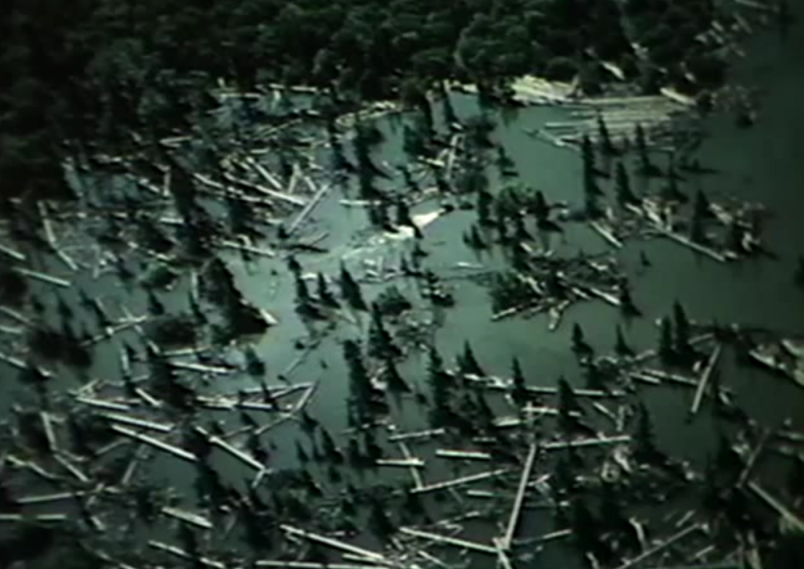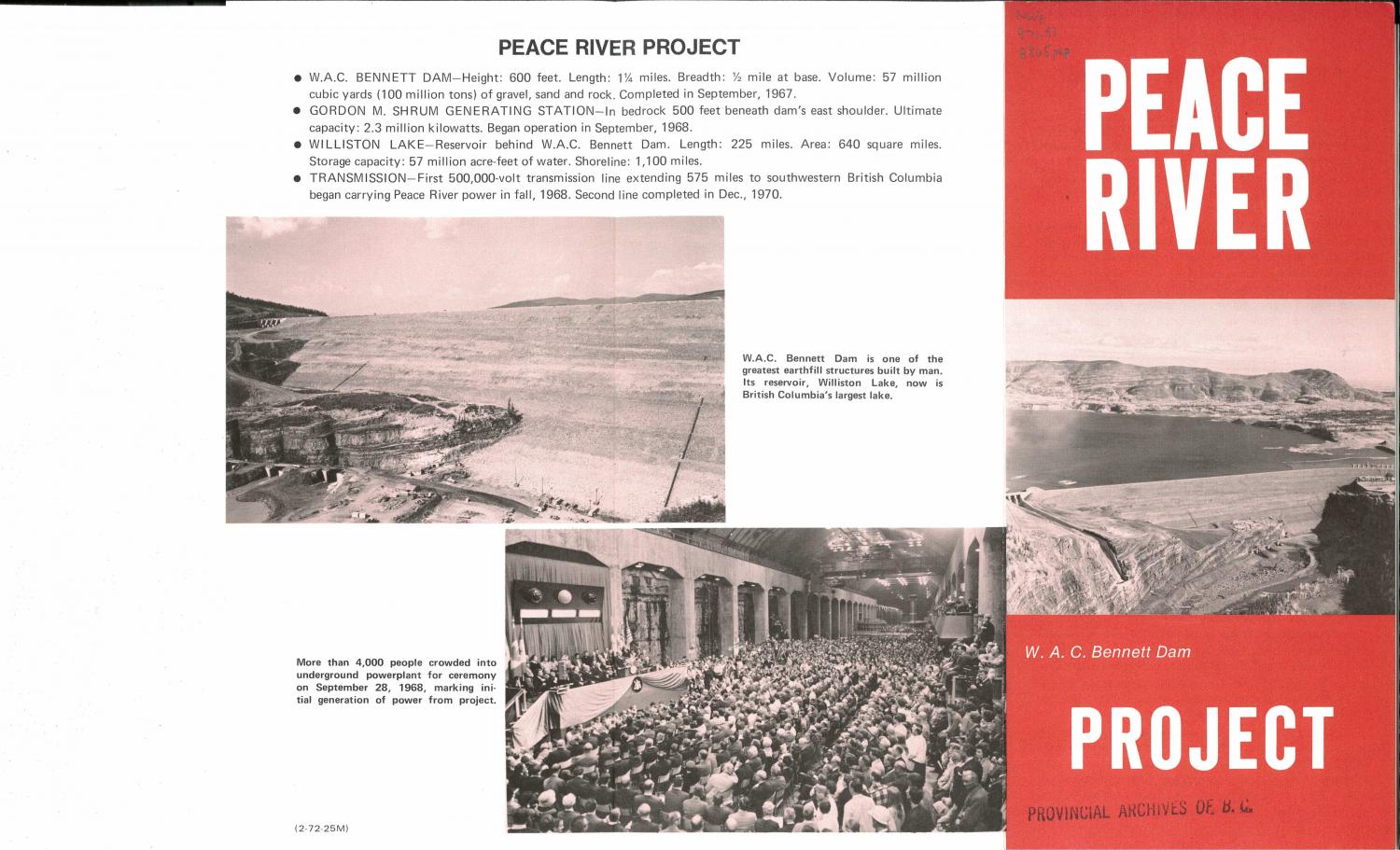Dam Displaces Tsek'ehne
Seventh-largest reservoir in the world upends traditional life for local Indigenous
Date: 1968
To Premier W.A.C. Bennett, the massive Peace River dam that bore his name was a modern triumph that had untapped the hydroelectric riches of British Columbia's backcountry. To the Kwadacha and Tsay Keh Dene Nations, who live in the province's remote northeast, it was a disaster. After years of construction, the 55-storey-high, 800-metre-long dam — then the largest in the Western world — went into operation in 1968. With that, B.C. had a new largest lake. The Williston Reservoir flooded 1,761 square kilometres of the Northern Rocky Mountain Trench, including the traditional lands of the Kwadacha and Tsay Keh Dene, member nations of the Tsek'ehne.
Consultation with the Tsek'ehne was sparse. Most meetings between government officials and Elders occurred after the project had already received a green light. Some Elders weren't consulted at all. Many in the community only learned of their fate once the waters had already begun to rise. Emil McCook, a former Kwadacha chief, remembers saving a young boy caught in an overturned boat when the tide began to rise.
The new Williston Reservoir flooded Fort Grahame, home to members of both nations. Burial grounds and traditional gathering places were washed out; valuable hunting and trapline territory erased. More than 12,000 moose are estimated to have drowned, while access to the migration route of caribou, which both nations hunted, was cut off. Both communities had nowhere to go. The new reservoir had engulfed the river system they and other nearby Indigenous peoples, including the Dane-zaa, had long used for travel.
"The river was our highway," Kwadacha Chief Donny Van Somer told Alaska Highway News in 2016. "It got flooded, and there was debris all over the place. You couldn't get anywhere. There was no roads where we were." Based in Fort Ware, a tiny settlement on the Finlay River, the Williston Reservoir effectively cut the Kwadacha off from the rest of civilization. Due to high winds and floating debris, travelling on the reservoir was too dangerous for the Kwadacha or Tsay Keh Dene, whose flat-bottomed boats were intended for river travel. Elders estimate nine people drowned following the dam's construction. Eventually, a logging road to Prince George was built and then a small airstrip, but access to the secluded community remains scant.
Meanwhile, the reservoir forced members of the Tsay Keh Dene, previously known as the Ingenika, onto new reserves near a newly-incorporated company town called Mackenzie, about 180 kilometres north of Prince George. But not long after, motivated by a growing rate of substance use among its members, the Tsay Keh Dene sought a more remote location. They settled at the northern tip of the Williston Reservoir, as close as possible to their previous home. In 1977, a consultant hired by BC Hydro said the displacement and isolation caused by the reservoir had "radically altered" Tsay Keh Dene life. He blamed Williston for the "high incidence of social disorganization" experienced by some community members in its wake. Ironically, more than 50 years after going into operation, neither the Kwadacha nor the Tsay Keh Dene benefit from the electricity generated by the Bennett Dam. Both communities still mostly rely on diesel generators.
In 2008, the Kwadacha settled with the province for the damages the Bennett Dam caused. The First Nation received an initial payment of $15 million, in addition to yearly payments of around $1.6-million. The following year, the Tsay Keh Dene signed a similar agreement with a one-time payment of $20.9 million and annual installments of roughly $2-million. In 2016, B.C. Hydro formally apologized to the Kwadacha and Tsay Keh Dene. The Crown company also unveiled a new installation at the Bennett Dam Visitor Centre entitled "Our Story, Our Voice." The gallery highlights the stories of Indigenous people directly impacted by the dam.
Sources:
1. Cox, Sarah. BC Hydro Apologizes for Bennett Dam's 'Profound and Painful' Impact on First Nations at Gallery Opening. The Narwhal, 10 June 2016, thenarwhal.ca/bc-hydro-apologizes-bennett-dam-s-profound-and-painful-impact-first-nations-gallery-opening.
2. Cox, Sarah. Breaching the Peace: the Site C Dam and a Valley's Stand against Big Hydro. On Point Press, 2018.
3. Fisher, Gavin. BC Hydro Acknowledges Dark Past of W.A.C. Bennett Dam in New Exhibit. CBC News, 15 June 2016, www.cbc.ca/news/canada/british-columbia/bc-hydro-acknowledges-dark-past-of-wac-bennett-dam-1.3637489.
4. Fong, Petti. Province, Natives Settle Claim over Flooding Caused by Dam. The Globe and Mail, 13 Dec. 2006, www.theglobeandmail.com/news/national/province-natives-settle-claim-over-flooding-caused-by-dam/article973014/.
5. Kwadacha Tsek’Ene First Nation People’s History. Kwadacha First Nation, www.kwadacha.com/language.
6. Littlefield, Loraine, et al. Tse Keh Nay Traditional and Contemporary Use and Occupation at Amazay (Duncan Lake): A Draft Report. Kemess North Joint Review Panel, May 2007, www.ceaa-acee.gc.ca/050/documents_staticpost/cearref_3394/hearings/SM01.pdf.
8. Loo, Tina. Disturbing the Peace: Environmental Change and the Scales of Justice on a Northern River. Oxford University Press, 1 Oct. 2007, envhis.oxfordjournals.org/content/12/4/895.
9. Poirier, Maggie. ‘They Call It Progress, We Call It Destruction’: Memory and the Construction of the W.A.C Bennett Dam. University of Northern British Columbia, 2010, theses.lib.sfu.ca/file/thesis/5589.
10. Pollon, Christopher, and Ben Nelms. “The Peace in Peril.” Maisonneuve, 12 Sept. 2017, maisonneuve.org/article/2017/09/12/peace-peril/#image-7.
11. Sims, Daniel. Dam Bennett: The Impacts of the W.A.C. Bennett Dam and Williston Lake Reservoir on the Tsek’Ehne of Northern British Columbia. University of Alberta, 2017, era.library.ualberta.ca/items/c7c87a83-8262-451d-a507-53d8cfbc8b79/view/05dba73b-eb93-4ace-82e0-415d1f164f6a/Sims_Daniel_CF_201712_PhD.pdf .
12. Telling a Story of Change the Dane-Zaa Way. The Treaty 8 First Nations (T8FNs) Community Assessment Team and The Firelight Group Research Cooperative, 27 Nov. 2012, www.ceaa-acee.gc.ca/050/documents_staticpost/63919/85328/Vol3_Appendix_B-Treaty_8.pdf.
13. Tsay Keh Dene Seeks Lands to Replace Reserves Flooded by Williston Reservoir. Alaska Highway News, 29 Jan. 2016, www.alaskahighwaynews.ca/bc-news/tsay-keh-dene-seeks-lands-to-replace-reserves-flooded-by-williston-reservoir-3491793.
14. Tsay Keh Dene Vote Yes to Williston Settlement Agreement. BC Hydro News, 2 July 2009, www.bchydro.com/news/press_centre/news_releases/2009/yes_vote_rights_historic.html.
15. Wakefield, Jonny. BC Hydro Acknowledges W.A.C. Bennett Dam's Dark Side. Dawson Creek Mirror, 10 June 2016, www.dawsoncreekmirror.ca/regional-news/site-c/bc-hydro-acknowledges-wac-bennett-dams-dark-side-3493113.


![Sikanni [Sekani] Chief Charlie Hunter and family at Fort Grahame.](https://bc-timeline-backend.azureedge.net/sites/default/files/styles/gallery_resized/public/images/i-33182.jpg)



